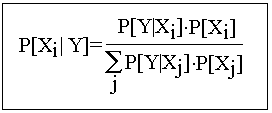
Bill Majoros
July 22, 1999
Then the probability of the point occurring in Xi is given by the following:

That is, the conditional probability of Xi given Y is equal to the value of the expression on the right. This is known as Bayes' Theorem, and it can be easily derived through the use of simple statistical identities (in particular, the repeated application of the so-called Multiplication rule: P[A & B]=P[A|B]*P[B]).
To develop an intuitive understanding of Bayes' Theorem, consider the sample space shown below:

Imagine that a sample point has been drawn from S, and we know only that the point lies in Y. Then the probability that that point also happens to lie in Xi can be assessed by computing the proportion of points in Y that actually lie in the intersection between Y and Xi. In Bayes' Theorem, the numerator counts the points in the intersection, and the denominator sums all the points in Y.
The relevance of Bayes' Theorem to the problem of classification
will be made clear shortly.
In a supervised learning scenario, the classifier is provided with a set of training examples prior to performing the real classification task. Each training example consists of an object to be classified, as well as the correct category to which it should be assigned. Thus, we begin with a learning phase, during which the classifier analyzes the training examples and builds a model to store any knowledge which was learned about the problem space. This model is later applied to help the classifier perform the real classification task.
In this case, we are concerned with classifiers that build
a Naive Bayes Model to perform classification.
Since the denominator in Bayes' Theorem is independent of i (and is always nonnegative), the numerator of the most likely Xi will also have the greatest magnitude. Thus, to perform classification, we need only compute the numerator in Bayes' Theorem for each Xi and then pick the Xi giving the largest value.
The problem has now been reduced to computing P[Y|Xi]*P[Xi].
P[Xi] can be trivially estimated by counting the training examples that fall into Xi and dividing by the size of the training set.
P[Y|Xi] is less trivial, and it is the computation of this term that warrants use of the word naive in the phrase Naive Bayes Model. The model is naive in the sense that it assumes (often unjustifiably) that the attribute values of object Y are independent.
Under this assumption, we can compute P[Y|Xi] by simply multiplying together the conditional probabilities of the attribute values of Y. For example, if Y has attributes color=blue and texture=smooth, we can (presumably) estimate P[Y|Xi] by computing P[blue|Xi]*P[smooth|Xi].
These conditional probabilities can be estimated by simply
observing the distribution of attribute values within Xi in the training
set. Thus, if half of the training examples in Xi are blue and one-third
are smooth, and if Xi contained 75% of the training set, then we would
assess the probability of Y belonging to Xi as 1/2 * 1/3 * 3/4 = 1/24,
or approximately 4.2%. If this turned out to be the highest probability,
we would assign Y to Xi.
Once these data structures have been computed, it is a simple matter to classify a new test case; one need only perform a series of table look-ups and multiplications in order to compute the numerators in Bayes' Theorem, and then simply select the Xi having the greatest such value.
The method performs best when attribute values approach
independence. For problems where attributes have many complex interactions,
there is less reason for optimism. However, the Naive Bayes Model
is a good candidate for a first attempt at learning a new classification
task.